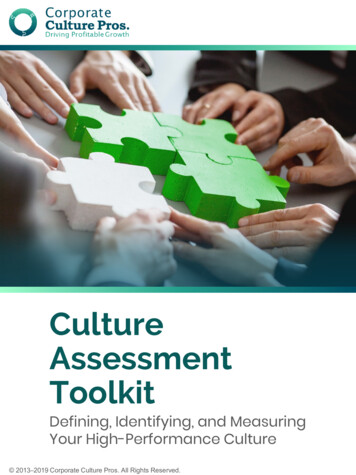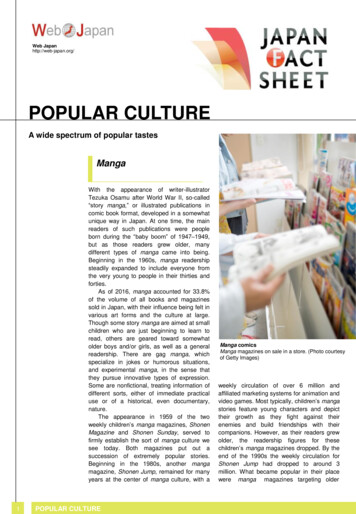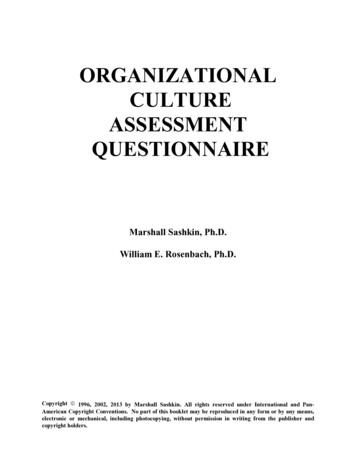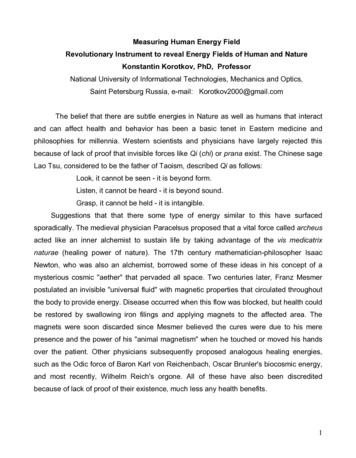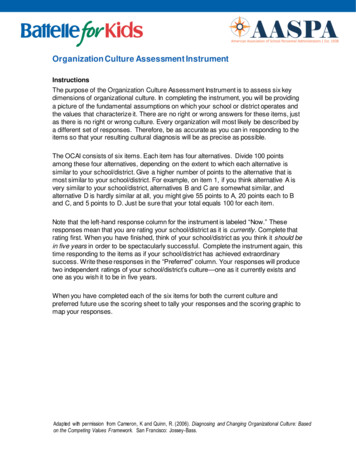
Transcription
Organization Culture Assessment InstrumentInstructionsThe purpose of the Organization Culture Assessment Instrument is to assess six keydimensions of organizational culture. In completing the instrument, you will be providinga picture of the fundamental assumptions on which your school or district operates andthe values that characterize it. There are no right or wrong answers for these items, justas there is no right or wrong culture. Every organization will most likely be described bya different set of responses. Therefore, be as accurate as you can in responding to theitems so that your resulting cultural diagnosis will be as precise as possible.The OCAI consists of six items. Each item has four alternatives. Divide 100 pointsamong these four alternatives, depending on the extent to which each alternative issimilar to your school/district. Give a higher number of points to the alternative that ismost similar to your school/district. For example, on item 1, if you think alternative A isvery similar to your school/district, alternatives B and C are somewhat similar, andalternative D is hardly similar at all, you might give 55 points to A, 20 points each to Band C, and 5 points to D. Just be sure that your total equals 100 for each item.Note that the left-hand response column for the instrument is labeled “Now.” Theseresponses mean that you are rating your school/district as it is currently. Complete thatrating first. When you have finished, think of your school/district as you think it should bein five years in order to be spectacularly successful. Complete the instrument again, thistime responding to the items as if your school/district has achieved extraordinarysuccess. Write these responses in the “Preferred” column. Your responses will producetwo independent ratings of your school/district’s culture—one as it currently exists andone as you wish it to be in five years.When you have completed each of the six items for both the current culture andpreferred future use the scoring sheet to tally your responses and the scoring graphic tomap your responses.Adapted with permission from Cameron, K and Quinn, R. (2006). Diagnosing and Changing Organizational Culture: Basedon the Competing Values Framework. San Francisco: Jossey-Bass.
The Organizational Culture Assessment Instrument1. Dominant CharacteristicsA. My school/district is a very personal place. It is like anextended family. People seem to share a lot ofthemselves.B. My school/district is a very dynamic and entrepreneurialplace. People are willing to stick their necks out and takerisks.C. My school/district is very results-oriented. A major concernis with getting the job done. People are very competitiveand achievement-oriented.D. My school/district is a very controlled and structured place.Formal procedures generally govern what people do.TotalNowPreferred1001002. Organizational LeadershipA. The leadership at my school/district is generallyconsidered to exemplify mentoring, facilitating, ornurturing.B. The leadership at my school/district is generallyconsidered to exemplify entrepreneurship, innovation, orrisk-taking.C. The leadership at my school/district is generallyconsidered to exemplify a no-nonsense, aggressive,results-oriented focus.D. The leadership at my school/district is generallyconsidered to exemplify coordinating, organizing, orsmooth-running efficiency.TotalNowPreferred1001003. Management of EmployeesA. The management style at my school/district ischaracterized by teamwork, consensus, and participation.B. The management style at my school/district ischaracterized by individual risk-taking, innovation,freedom, and uniqueness.C. The management style at my school/district ischaracterized by hard-driving competitiveness, highdemands, and achievement.D. The management style at my school/district ischaracterized by security of employment, conformity,predictability, and stability in relationships.TotalNowPreferred100100
4. Organization GlueA. The glue that holds my school/district together is loyalty,and mutual trust. Commitment to this organization runshigh.B. The glue that holds my school/district together iscommitment to innovation and development. There is anemphasis on being on the cutting edge.C. The glue that holds my school/district together is theemphasis on achievement and goal accomplishment.D. The glue that holds my school/district together is formalrules and policies. Maintaining a smooth-runningorganization is important.TotalNowPreferred1001005. Strategic EmphasisA. My school/district emphasizes human development. Hightrust, openness, and participation persist.B. My school/district emphasizes acquiring new resourcesand creating new challenges. Trying new things andprospecting for opportunities are valued.C. My school/district emphasizes competitive actions andachievement. Hitting achievement targets and producinghigh levels of growth is dominant.D. My school/district emphasizes permanence and stability.Efficiency, control, and smooth operations are important.TotalNowPreferred1001006. Criteria of SuccessA. My school/district defines success on the basis of thedevelopment of human resources, teamwork, employeecommitment, and concern for people.B. My school/district defines success based on theprevalence of innovative and cutting edge instructionalpractices.C. My school/district defines success on the basis test scoresand value-added gains.D. My school/district defines success on the basis ofefficiency. Dependable delivery, smooth scheduling, andlow-cost practice are critical.TotalNowPreferred100100
Worksheet for Scoring the OCAI“Now” Scores1A2A3A4A5A6ASum (total of A responses)Average (Sum divided by 6)Organization Name“Preferred” Scores1A2A3A4A5A6ASum (total of A responses)Average (Sum divided by 6)1B2B3B4B5B6BSum (total of B responses)Average (Sum divided by 6)1B2B3B4B5B6BSum (total of B responses)Average (Sum divided by 6)1C2C3C4C5C6CSum (total of C responses)Average (Sum divided by 6)1C2C3C4C5C6CSum (total of C responses)Average (Sum divided by 6)1D2D3D4D5D6DSum (total of D responses)Average (Sum divided by 6)1D2D3D4D5D6DSum (total of D responses)Average (Sum divided by 6)1. Plot the average of your A scores in the YellowQuadrant.2. Plot the average of your B scores in the GreenQuadrant.3. Plot the average of your C scores in the BlueQuadrant.4. Plot the average of your D scores in theRed Quadrant.5. Connect the dots with a solid line.1. Plot the average of your A scores in the YellowQuadrant.2. Plot the average of your B scores in the GreenQuadrant.3. Plot the average of your C scores in the BlueQuadrant.4. Plot the average of your D scores in theRed Quadrant.5. Connect the dots with a dashed line.
Scoring Graphic for theOrganizational Culture Assessment InstrumentRelationshipsContinuous Improvement5050404030 Collaboration Student-CenteredFocus Support Respect Care Belonging3020201010INTERNALFOCUS Structures Routines Efficiency Management Content Knowledge Security10102020 Adaptability Visioning Relevance Creativity Experimentation Enthusiasm Goal Focus Accountability Assessment Achievement High-quality Work Accomplishment303040405050Stable EnvironmentHigh ExpectationsORDER & CONTROLHC Education Leaders Learning SeriesPresented by Battelle for KidsEXTERNALFOCUS
Organization Culture Assessment Instrument Instructions The purpose of the Organization Culture Assessment Instrument is to assess six key dimensions of organizational culture. In completing the instrument, you will be providing a picture of the fundamental assumptions on which your school or district operates and the values that characterize it. There are no right or wrong answers for these .


